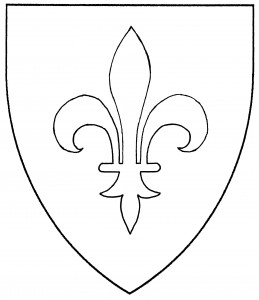The fleur-de-lys is one of the most ancient of charges, dating from 1244 in the arms of the Kings of France [Asp2 218]. It has been said to represent a lance-head, or a symbol of the Trinity, but is usually described as a stylized form of iris or lily flower. The fleur-de-lys has been used throughout England and the Continent, but is most strongly associated with France. In England, it was also used as the brisure of the sixth son.
A semy field of fleurs-de-lys is termed “semy-de-lys”; the terms “floretty” or “fleury” are sometimes used for this, but these should be reserved for charges (e.g., the cross) decorated with fleurs-de-lys.
The arms of France were anciently “Azure semy-de-lys Or,” and changed c.1365 to “Azure, three fleurs-de-lys Or.” So strong is the association of French royalty (or augmentations therefrom) with gold fleurs-de-lys on a blue background, that the use of France Ancient or France Modern – effectively, three or more gold fleurs-de-lys on a blue background – is disallowed in Society heraldry: either on any part of the field, or on a charge.
There were many styles of fleur-de-lys used in period; the illustration shows a representative medieval form, from the arms of France c.1460 [GATD 47v, also Friar 100]. See also lily.
The Order of the Calon Lily bears: Per pale purpure and Or, a fleur-de-lys within a bordure counterchanged.
Stefan de Lorraine bears: Argent, a fleur-de-lys gules.
Nikolas de Mont Nord bears: Sable, a fleur-de-lys ermine.
Christopher Calhoune bears: Or, three fleurs-de-lys gules.
